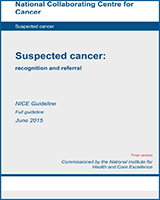From: 12, Urological cancers

Suspected Cancer: Recognition and Referral.
NICE Guideline, No. 12.
National Collaborating Centre for Cancer (UK).
London: National Institute for Health and Care Excellence (NICE); 2015 Jun.
Copyright © National Collaborating Centre for Cancer.
NCBI Bookshelf. A service of the National Library of Medicine, National Institutes of Health.